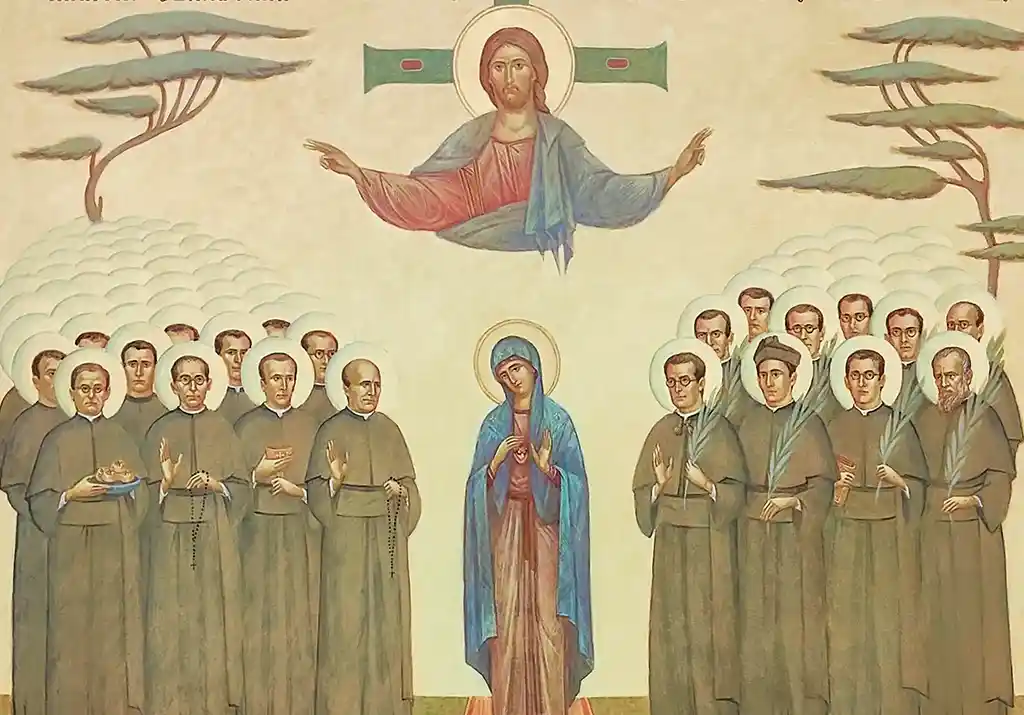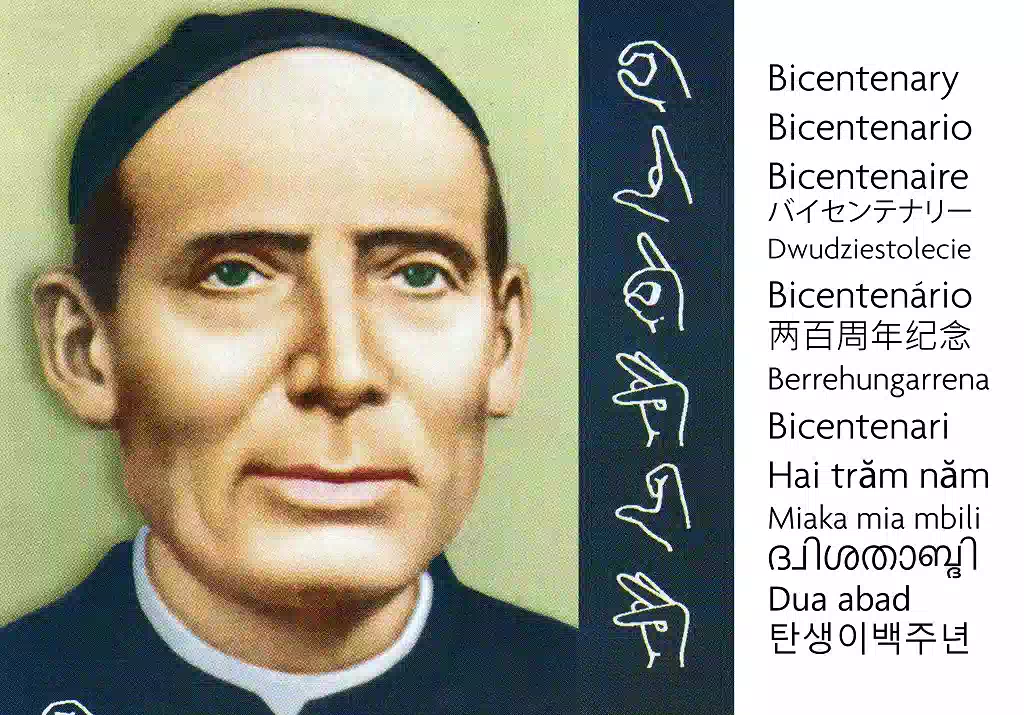 Barcelona, Spain. Angelo Cardinal Amato, Prefect of the Congregation for the Causes of Saints, on behalf of Pope Francis, presided this Saturday morning, October 21, in the Basilica of the Sagrada Familia of Barcelona, the beatification of 109 Claretian martyrs. This is the first beatification to be made in the Basilica, since it was consecrated in 2010 by Pope Benedict XVI. It is also the largest beatification of martyrs of a single religious congregation ever held.
Barcelona, Spain. Angelo Cardinal Amato, Prefect of the Congregation for the Causes of Saints, on behalf of Pope Francis, presided this Saturday morning, October 21, in the Basilica of the Sagrada Familia of Barcelona, the beatification of 109 Claretian martyrs. This is the first beatification to be made in the Basilica, since it was consecrated in 2010 by Pope Benedict XVI. It is also the largest beatification of martyrs of a single religious congregation ever held.
3,000 faithful attended the celebration and thirty Claretian and non-claretian bishops from around the world and more than 300 priests have concelebrated. The Archbishop of Barcelona, Juan José Cardinal Omella, and Father General, Fr. Mathew Vattamattam, have been the main concelebrants.
The homily of Cardinal Amato began by remembering the cry “We are not afraid” that was heard in the streets of Barcelona after the attacks in August: “Terrorism wants to infuse fear, but the people respond with a single voice: ‘we do not have fear’“. It is a sample of how “man has a vocation to life and not to death, to love and not to hatred“.
Cardinal Amato recalled that the persecutions of Christians have been present since Roman times and continue today in many countries. All are a sign that “nothing can separate us from the love of God” and how “love always defeats hatred“. In this case, before the “epidemic of death and destruction, the 109 Claretians reacted with the effective weapon of love and forgiveness. They were not afraid and are 109 heroic witnesses of the Gospel. ” “The only Christian revenge is the forgiveness of enemies, not to propose hatred but the eternal Christian law of love“, remarked the cardinal. “We are comforted by the strength and dignity of all the religious who were murdered; none of them adjured of their faith because they were not afraid to show the world that good overcomes evil“.
Among those who attended, there were over one thousand relatives of the 109 martyrs and representatives of the populations of origin, including a dozen mayors. 73 new martyrs are born in Catalonia, 14 in Navarre, 4 in Huesca, 5 Burgos, 2 in Logroño, 2 in Palencia, 2 in Zaragoza, 2 in Teruel, 1 in Álava, 1 in Cádiz, 1 in Madrid, 1 to Valencia, and 1 of Auch (France).
 Claretians from all over the world, including fourteen Claretian bishops, attended the beatification acts. Nigeria, Equatorial Guinea, Mexico, Cameron, Honduras, Panama, Colombia, Venezuela, India, Sri Lanka, Bolivia, Argentina, Chile, Peru, the United States, the Philippines, Canada, Korea and Indonesia are some of the countries represented in the beatification. Also present were the Claretians from all over Europe and members of the General Government.
Claretians from all over the world, including fourteen Claretian bishops, attended the beatification acts. Nigeria, Equatorial Guinea, Mexico, Cameron, Honduras, Panama, Colombia, Venezuela, India, Sri Lanka, Bolivia, Argentina, Chile, Peru, the United States, the Philippines, Canada, Korea and Indonesia are some of the countries represented in the beatification. Also present were the Claretians from all over Europe and members of the General Government.
In addition to the Claretian bishops throughout the world, the bishops of Catalonia and other dioceses of Spain to which the 109 martyrs were born, the abbots of Montserrat and Poblet, and the Apostolic nuncio Renzo Fratini, have also concelebrated. The Government of the Generalitat de Catalunya has been represented by the Minister of the Interior, Public Administrations and Housing, Meritxell Borràs, representing the President of the Generalitat.
At the beginning of the Eucharist, the beatification rite was celebrated, proclaiming the 109 martyrs as blessed and public veneration may be rendered in their honor. Cardinal Omella has made the public petition for the beatification and the vice-postulator of the Province of Catalunya, Father Manuel Casal, summarized their cause: “these are priests, lay brothers and students who, in the tragic events ofSpanish civil war from 1936 to 1939 suffered, in the name of Christ, a violent death, just because they had remained faithful to their Christian and religious vocation.” Father Casal remarked that “from the depths of this untransferable identity, they knew how to be faithful to the yes pronounced the day of his religious Profession “
After the petition, Cardinal Amato publicly read the Apostolic Letter of Pope Francis. The text is the Pope’s recognition of the beatification and establishes February 1 as the date to celebrate the feast: “We grant the faculty that the Venerable Servants of God: Matthew, Theophilus, Ferran and 106 Companions of the Congregation of the Missionaries Claretians, heroic witnesses of the Lord Jesus to the point of shedding their blood, from now on will be called Blesseds and may celebrate their feast every year, in the places and according to the ways established by law, on February 1st.”
 After the reading of the Apostolic Letter, the most emotional moment of the celebration has arrived, in which a great icon of the martyrs with the song “Christus vincit” and applause has been unveiled. The image is a symbolic representation of the 109 martyrs in which the center is the Heart of Mary, the Virgin, which is also center of Claretian spirituality.
After the reading of the Apostolic Letter, the most emotional moment of the celebration has arrived, in which a great icon of the martyrs with the song “Christus vincit” and applause has been unveiled. The image is a symbolic representation of the 109 martyrs in which the center is the Heart of Mary, the Virgin, which is also center of Claretian spirituality.
The artist of the icon is Laura Alberich, a painter who reproduces Romanesque images on wood using the same technique used by the monks in the Middle Ages. In the beatification ceremonies it is customary to make an image of the beatified person. In this case, Laura Alberich has not reproduced the 109 martyrs but has adapted it to the iconic representations of the Claretians, such as the flames.The flames indicate how Saint Anthony Maria Claret asked the missionaries to “burn in charity”.
The seven largest flames represent the seven communities in which the martyrs belonged: Cervera – Mas Claret and Solsona (60), Barcelona (8), Sabadell (8), Lleida (11), Vic and Sallent Santander (3) and Valencia (4). Only the image of the 3 Blesseds that represents the cause and that of Father Claret, bishop and founder of the congregation, appears.
 Just after the proclamation, a procession with the reliquary was begun that contained the relics of some of the martyrs. The reliquary has been placed next to the altar presiding over the celebration.
Just after the proclamation, a procession with the reliquary was begun that contained the relics of some of the martyrs. The reliquary has been placed next to the altar presiding over the celebration.
The majority of remains of the martyrs have been grouped in the Pantheon that the Claretian Missionaries have in the Cemetery of Cervera. An important group still lies in the cemetery of Lleida in a common grave where they were buried with other victims of the War. There are also other martyrs buried in the crypt of the tomb of Sant Antonio Maria Claret in Vic, and other churches in Sallent, Solsona and Tàrrega, the mausoleum of brother Saperas. In other cases, although there are witnesses to his death, no remains are preserved, either because their bodies were abandoned or, as in the case of Mas Claret, because they were burned.
At the end of the celebration, Cardinal Omella and Father Vattamattam have spoken a word of thanks, also addressed to Pope Francis for having approved the beatification.
The archbishop of Barcelona, Juan Jose Omella, stressed that the martyrs “witnessed firmness in faith, forgiveness, love for Jesus Christ and the Church, reconciliation in times convulsed and hope in eternal life. I wish we could welcome it and live it in our own lives and in this moment of our history. ” He also called for “the testimony of these brave and humble witnesses, who die forgiving and imploring peace for the world, help us to live generously our faith, also in these moments of our history.” May the Lord help us to be carriers peace, reconciliation, love and respect for all people, always favoring areas of dialogue, mutual knowledge and understanding. “
 Father Mathew Vattamattam has been very grateful.He has presented the new Blesseds as examples of joy: “The joy of the Gospel is a gift of the Christian faith. Our missionaries, despite their sufferings, died with joy.” And he explained that “today we rejoice with them because they were faithful to the end” and because “they show us the way of fidelity to the Gospel.” “Martyrs exist and they remind us that true faith is measured by the ability to lay down our lives for others,” Father Mathew said, calling for their testimony to be seed of new missionaries.
Father Mathew Vattamattam has been very grateful.He has presented the new Blesseds as examples of joy: “The joy of the Gospel is a gift of the Christian faith. Our missionaries, despite their sufferings, died with joy.” And he explained that “today we rejoice with them because they were faithful to the end” and because “they show us the way of fidelity to the Gospel.” “Martyrs exist and they remind us that true faith is measured by the ability to lay down our lives for others,” Father Mathew said, calling for their testimony to be seed of new missionaries.
Father General especially thanked Cardinal Omella for hosting the beatifications in his Diocese of Barcelona as well as for the generous collaboration of the authorities in the Sagrada Familia in the organization.
The 109 martyrs were killed because of the faith and the condition of religious at the beginning of the Civil War, the majority in Catalonia. In the celebrations the reconciliation and the testimony of those who died for not renouncing their faith and offered the pardon are emphasized.








